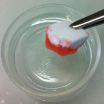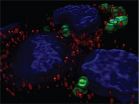(Press-News.org) All industrial nations need large volumes of oil which is normally delivered by ocean-going tankers or via inland waterways to its destination. The most environmentally-friendly way of cleaning up nature after an oil spill accident is to absorb and recover the floating film of oil. The Empa researchers Tanja Zimmermann and Philippe Tingaut, in collaboration with Gilles Sèbe from the University of Bordeaux, have now succeeded in developing a highly absorbent material which separates the oil film from the water and can then be easily recovered, "silylated" nanocellulose sponge. In laboratory tests the sponges absorbed up to 50 times their own weight of mineral oil or engine oil. They kept their shape to such an extent that they could be removed with pincers from the water. The next step is to fine tune the sponges so that they can be used not only on a laboratory scale but also in real disasters. To this end, the a partner from industry is currently seeked.
One step production – from cellulose plants
Nanofibrillated Cellulose (NFC), the basic material for the sponges, is extracted from cellulose-containing materials like wood pulp, agricultural by products (such as straw) or waste materials (such as recycled paper) by adding water to them and pressing the aqueous pulp through several narrow nozzles at high pressure. This produces a suspension with gel-like properties containing long and interconnected cellulose nanofibres .
When the water from the gel is replaced with air by freeze-drying, a nanocellulose sponge is formed which absorbs both water and oil. This pristine material sinks in water and is thus nott useful for the envisaged purpose. The Empa researchers have succeeded in modifying the chemical properties of the nanocellulose in just one process step by admixing a reactive alkoxysilane moleculein the gel before freeze-drying. The nanocellulose sponge loses its hydrophilic properties, is no longer suffused with water and only binds with oily substances.
In the laboratory the "silylated" nanocellulose sponge absorbed test substances like engine oil, silicone oil, ethanol, acetone or chloroform within seconds. Nanofibrillated cellulose sponge, therefore, reconciles several desirable properties: it is absorbent, floats reliably on water even when fully saturated and is biodegradable.
INFORMATION: END
Nanocellulose sponges to combat oil pollution
Miracle cure made from plants
2014-05-06
ELSE PRESS RELEASES FROM THIS DATE:
Molecular switches age-related memory decline? Genetic variant protect against brain aging
2014-05-06
Philadelphia, PA, May 6, 2014 – Even among the healthiest individuals, memory and cognitive abilities decline with age. This aspect of normal aging can affect an individual's quality of life and capability to live independently but the rate of decline is variable across individuals. There are many factors that can influence this trajectory, but perhaps none more importantly than genetics.
Scientists are seeking to identify key molecular switches that control age-related memory impairment. When new molecules are identified as critical to the process of memory consolidation, ...
Yawning to cool the brain
2014-05-06
Common belief is that yawning helps to increase the oxygen supply. However, previous research has failed to show an association between yawning and blood oxygen levels. New research by a team of researchers led by Psychologist Andrew Gallup of SUNY College at Oneonta, USA now reveals that yawning cools the brain.
Sleep cycles, cortical arousal and stress are all associated with fluctuations in brain temperature, Yawning subsequently functions to keep the brain temperature balanced and in optimal homeostasis. According to this theory, yawning should also be easily manipulated ...
Exenatide has potential as a disease modifying agent in Parkinson's disease
2014-05-06
Amsterdam, NL, 5 May 2014 – A follow-up study of patients with Parkinson's disease (PD) who participated in an earlier "proof of concept" clinical trial using exenatide showed that improvements persisted twelve months after discontinuing exenatide therapy. These data provide strong encouragement for the further study of this drug in patients with PD, report researchers in the Journal of Parkinson's Disease.
Several recent discoveries have highlighted common cellular pathways that potentially relate neurodegenerative processes with abnormal mitochondrial function and abnormal ...
Genetic risk factor for premature birth found
2014-05-06
Researchers at the University of California, San Diego School of Medicine have discovered a genetic risk factor for premature birth. The risk factor is related to a gene that codes for a protein that the scientists have found helps the body's immune cells recognize and fight Group B Streptococcus (GBS) bacteria.
These bacteria are found in the vagina or lower gastrointestinal tract of approximately 15 to 20 percent of healthy women, but may cause life-threatening infections, such as sepsis or meningitis in newborns, especially those born prematurely.
The study is published ...
Hypertension related to new cancer therapies -- a new syndrome emerges
2014-05-06
Philadelphia, PA, May 5, 2014 – New cancer therapies, particularly agents that block vascular endothelial growth factor (VEGF) signaling, have improved the outlook for patients with some cancers and are now used as a first line therapy for some tumors. However, almost 100% of patients who take VEGF inhibitors (VEGFIs) develop high blood pressure, and a subset develops severe hypertension. The mechanisms underlying VEGF inhibitor-induced hypertension need to be better understood and there is a need for clear guidelines and improved management, say investigators in a review ...
After single moms get laid off, their kids may suffer for years
2014-05-06
When single mothers lose their jobs, their children suffer significant negative effects as young adults, according to a new study by researchers at the California Center for Population Research at UCLA.
The study focused on two sets of outcomes for the children — educational achievement and social-psychological well-being. Specifically, researchers evaluated whether those in the study had graduated from high school by age 19, attended college by age 21 and graduated from college by age 25; and whether they exhibited symptoms of depression between the ages of 20 and 24 ...
UCLA's 'Laughter Guy' dissects features of counterfeit chortling
2014-05-06
Ever wonder how often you fool your boss or in-laws by pretending to laugh at their dumb jokes?
The answer is probably just over one-third of the time, according to new research by a UCLA communication expert who has conducted research on fake laughs.
When your fake laughs fall short of convincing, tiny subtleties of your breathing are probably giving you away, suggests Greg Bryant, an associate professor of communication studies at UCLA.
"Quite a few fake laughs sound pretty good, but listeners seem to pay attention to certain acoustic features that are really hard ...
The new face of tofu
2014-05-06
Tofu has long been a favorite among vegetarians and families with eastern ancestry. But now Tofu is becoming a bigger part of western diets, especially with 20-something women who want dishes that are quick, easy to cook and that can help keep them trim.
A new Cornell study, published in Eating Behaviors, involving 502 young women (20-35 years old) showed that tofu lovers saw it as a great source of light, inexpensive, energizing protein. "Importantly, they also believed you could cook firm Tofu just like chicken, but you didn't have to worry about it spoiling," said ...
Study finds ADHD and trauma often go hand in hand
2014-05-06
VANCOUVER, BRITISH COLUMBIA – When children struggle with focusing on tasks, staying organized, controlling their behavior and sitting still, they may be evaluated for attention-deficit/hyperactivity disorder (ADHD). Clinicians, however, shouldn't stop there, according to a study to be presented Tuesday, May 6, at the Pediatric Academic Societies (PAS) annual meeting in Vancouver, British Columbia, Canada.
Researchers found that many children with ADHD also face challenges such as poverty, divorce, neighborhood violence and substance abuse among family members.
"Our ...
Mealtime TV viewing during pregnancy may set stage for childhood obesity
2014-05-06
VANCOUVER, BRITISH COLUMBIA – Turning the TV off during mealtimes to help prevent childhood obesity may need to start even before a child is born, according to a study to be presented Tuesday, May 6, at the Pediatric Academic Societies (PAS) annual meeting in Vancouver, British Columbia, Canada.
Researchers found that pregnant women who watched television while eating were more likely to sit in front of the TV while feeding their infant. TV watching during meals is discouraged because it is associated with poorer quality diet, and mothers pay less attention to whether ...
LAST 30 PRESS RELEASES:
First Editorial of 2026: Resisting AI slop
Joint ground- and space-based observations reveal Saturn-mass rogue planet
Inheritable genetic variant offers protection against blood cancer risk and progression
Pigs settled Pacific islands alongside early human voyagers
A Coral reef’s daily pulse reshapes microbes in surrounding waters
EAST Tokamak experiments exceed plasma density limit, offering new approach to fusion ignition
Groundbreaking discovery reveals Africa’s oldest cremation pyre and complex ritual practices
First breathing ‘lung-on-chip’ developed using genetically identical cells
How people moved pigs across the Pacific
Interaction of climate change and human activity and its impact on plant diversity in Qinghai-Tibet plateau
From addressing uncertainty to national strategy: an interpretation of Professor Lim Siong Guan’s views
Clinical trials on AI language model use in digestive healthcare
Scientists improve robotic visual–inertial trajectory localization accuracy using cross-modal interaction and selection techniques
Correlation between cancer cachexia and immune-related adverse events in HCC
Human adipose tissue: a new source for functional organoids
Metro lines double as freight highways during off-peak hours, Beijing study shows
Biomedical functions and applications of nanomaterials in tumor diagnosis and treatment: perspectives from ophthalmic oncology
3D imaging unveils how passivation improves perovskite solar cell performance
Enriching framework Al sites in 8-membered rings of Cu-SSZ-39 zeolite to enhance low-temperature ammonia selective catalytic reduction performance
AI-powered RNA drug development: a new frontier in therapeutics
Decoupling the HOR enhancement on PtRu: Dynamically matching interfacial water to reaction coordinates
Sulfur isn’t poisonous when it synergistically acts with phosphine in olefins hydroformylation
URI researchers uncover molecular mechanisms behind speciation in corals
Chitin based carbon aerogel offers a cleaner way to store thermal energy
Tracing hidden sources of nitrate pollution in rapidly changing rural urban landscapes
Viruses on plastic pollution may quietly accelerate the spread of antibiotic resistance
Three UH Rainbow Babies & Children’s faculty elected to prestigious American Pediatric Society
Tunnel resilience models unveiled to aid post-earthquake recovery
Satellite communication systems: the future of 5G/6G connectivity
Space computing power networks: a new frontier for satellite technologies
[Press-News.org] Nanocellulose sponges to combat oil pollutionMiracle cure made from plants




